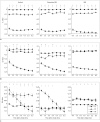Differentiation of the Infarct Core from Ischemic Penumbra within the First 4.5 Hours, Using Diffusion Tensor Imaging-Derived Metrics: A Rat Model
- PMID: 28246507
- PMCID: PMC5313515
- DOI: 10.3348/kjr.2017.18.2.269
Differentiation of the Infarct Core from Ischemic Penumbra within the First 4.5 Hours, Using Diffusion Tensor Imaging-Derived Metrics: A Rat Model
Abstract
Objective: To investigate whether the diffusion tensor imaging-derived metrics are capable of differentiating the ischemic penumbra (IP) from the infarct core (IC), and determining stroke onset within the first 4.5 hours.
Materials and methods: All procedures were approved by the local animal care committee. Eight of the eleven rats having permanent middle cerebral artery occlusion were included for analyses. Using a 7 tesla magnetic resonance system, the relative cerebral blood flow and apparent diffusion coefficient maps were generated to define IP and IC, half hour after surgery and then every hour, up to 6.5 hours. Relative fractional anisotropy, pure anisotropy (rq) and diffusion magnitude (rL) maps were obtained. One-way analysis of variance, receiver operating characteristic curve and nonlinear regression analyses were performed.
Results: The evolutions of tensor metrics were different in ischemic regions (IC and IP) and topographic subtypes (cortical, subcortical gray matter, and white matter). The rL had a significant drop of 40% at 0.5 hour, and remained stagnant up to 6.5 hours. Significant differences (p < 0.05) in rL values were found between IP, IC, and normal tissue for all topographic subtypes. Optimal rL threshold in discriminating IP from IC was about -29%. The evolution of rq showed an exponential decrease in cortical IC, from -26.9% to -47.6%; an rq reduction smaller than 44.6% can be used to predict an acute stroke onset in less than 4.5 hours.
Conclusion: Diffusion tensor metrics may potentially help discriminate IP from IC and determine the acute stroke age within the therapeutic time window.
Keywords: Diffusion magnitude; Diffusion tensor imaging; Infarct core; Ischemic penumbra; Pure anisotropy.
Figures





Similar articles
-
Diffusion Tensor-Derived Properties of Benign Oligemia, True "at Risk" Penumbra, and Infarct Core during the First Three Hours of Stroke Onset: A Rat Model.Korean J Radiol. 2018 Nov-Dec;19(6):1161-1171. doi: 10.3348/kjr.2018.19.6.1161. Epub 2018 Oct 18. Korean J Radiol. 2018. PMID: 30386147 Free PMC article.
-
Machine learning-based segmentation of ischemic penumbra by using diffusion tensor metrics in a rat model.J Biomed Sci. 2020 Jul 15;27(1):80. doi: 10.1186/s12929-020-00672-9. J Biomed Sci. 2020. PMID: 32664906 Free PMC article.
-
Perfusion computed tomography thresholds defining ischemic penumbra and infarct core: studies in a rat stroke model.Int J Stroke. 2015 Jun;10(4):553-9. doi: 10.1111/ijs.12147. Epub 2013 Oct 21. Int J Stroke. 2015. PMID: 24138577
-
The role of diffusion tensor imaging in the evaluation of ischemic brain injury - a review.NMR Biomed. 2002 Nov-Dec;15(7-8):561-9. doi: 10.1002/nbm.786. NMR Biomed. 2002. PMID: 12489102 Review.
-
[The clinical application of diffusion weighted magnetic resonance imaging to acute cerebrovascular disorders].No To Shinkei. 1998 Sep;50(9):787-95. No To Shinkei. 1998. PMID: 9789301 Review. Japanese.
Cited by
-
Early neuroimaging and ultrastructural correlates of injury outcome after neonatal hypoxic-ischaemia.Brain Commun. 2021 Mar 26;3(2):fcab048. doi: 10.1093/braincomms/fcab048. eCollection 2021. Brain Commun. 2021. PMID: 33981995 Free PMC article.
-
Synthetic Adrenocorticotropic Peptides Modulate the Expression Pattern of Immune Genes in Rat Brain following the Early Post-Stroke Period.Genes (Basel). 2023 Jun 30;14(7):1382. doi: 10.3390/genes14071382. Genes (Basel). 2023. PMID: 37510287 Free PMC article.
-
Estimating the volume of penumbra in rodents using DTI and stack-based ensemble machine learning framework.Eur Radiol Exp. 2024 May 15;8(1):59. doi: 10.1186/s41747-024-00455-z. Eur Radiol Exp. 2024. PMID: 38744784 Free PMC article.
-
Anisotropy component of DTI reveals long-term neuroinflammation following repetitive mild traumatic brain injury in rats.Eur Radiol Exp. 2024 Jul 24;8(1):82. doi: 10.1186/s41747-024-00490-w. Eur Radiol Exp. 2024. PMID: 39046630 Free PMC article.
-
Altered diffusivity of the subarachnoid cisterns in the rat brain following neurological disorders.Biomed J. 2023 Feb;46(1):134-143. doi: 10.1016/j.bj.2022.01.006. Epub 2022 Jan 21. Biomed J. 2023. PMID: 35066210 Free PMC article.
References
-
- Hacke W, Kaste M, Bluhmki E, Brozman M, Dávalos A, Guidetti D, et al. Thrombolysis with alteplase 3 to 4.5 hours after acute ischemic stroke. N Engl J Med. 2008;359:1317–1329. - PubMed
-
- Kang DW, Kwon JY, Kwon SU, Kim JS. Wake-up or unclear-onset strokes: are they waking up to the world of thrombolysis therapy? Int J Stroke. 2012;7:311–320. - PubMed
-
- Bhagat YA, Hussain MS, Stobbe RW, Butcher KS, Emery DJ, Shuaib A, et al. Elevations of diffusion anisotropy are associated with hyper-acute stroke: a serial imaging study. Magn Reson Imaging. 2008;26:683–693. - PubMed
-
- Sakai K, Yamada K, Nagakane Y, Mori S, Nakagawa M, Nishimura T. Diffusion tensor imaging may help the determination of time at onset in cerebral ischaemia. J Neurol Neurosurg Psychiatry. 2009;80:986–990. - PubMed
-
- Puig J, Blasco G, Daunis-I-Estadella J, Thomalla G, Castellanos M, Soria G, et al. Increased corticospinal tract fractional anisotropy can discriminate stroke onset within the first 4.5 hours. Stroke. 2013;44:1162–1165. - PubMed
MeSH terms
LinkOut - more resources
Full Text Sources
Other Literature Sources

